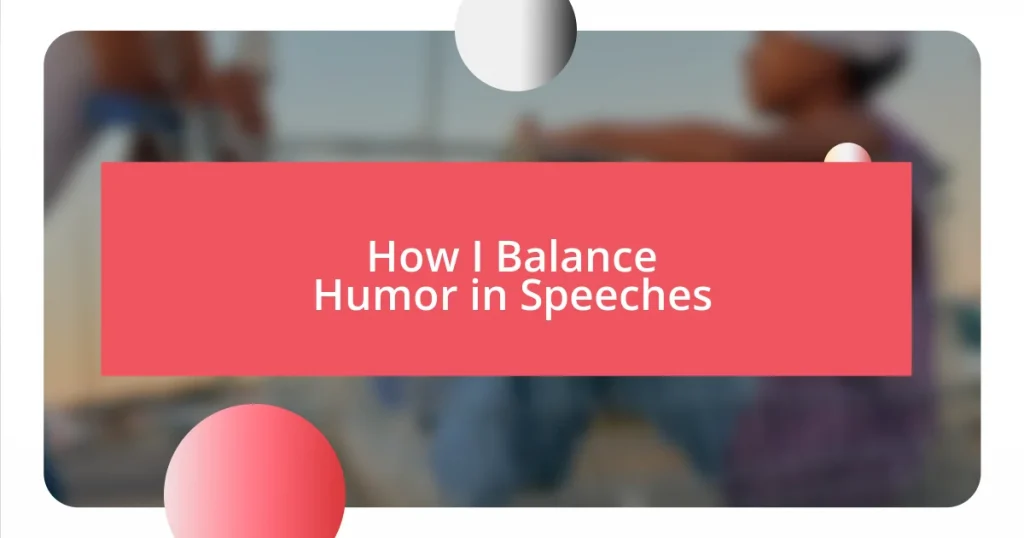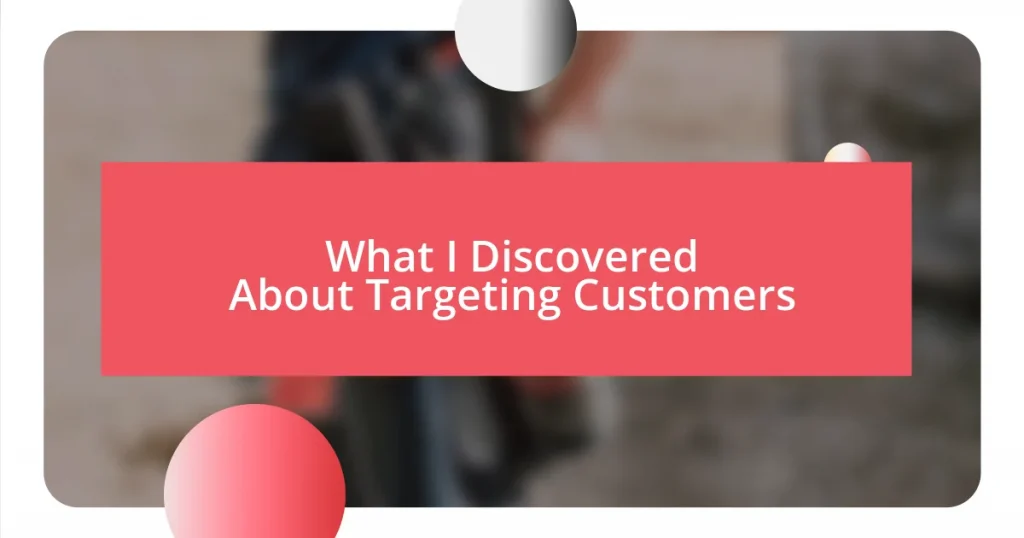Key takeaways:
- Humor can engage the audience, break down barriers, and enhance memory retention when tied to personal stories or relatable analogies.
- Understanding the audience’s humor and mood is crucial for effective delivery; tailored humor resonates better across different demographics.
- Timing and pacing are essential for incorporating humor naturally; practice and awareness of audience reactions can significantly improve delivery and audience connection.
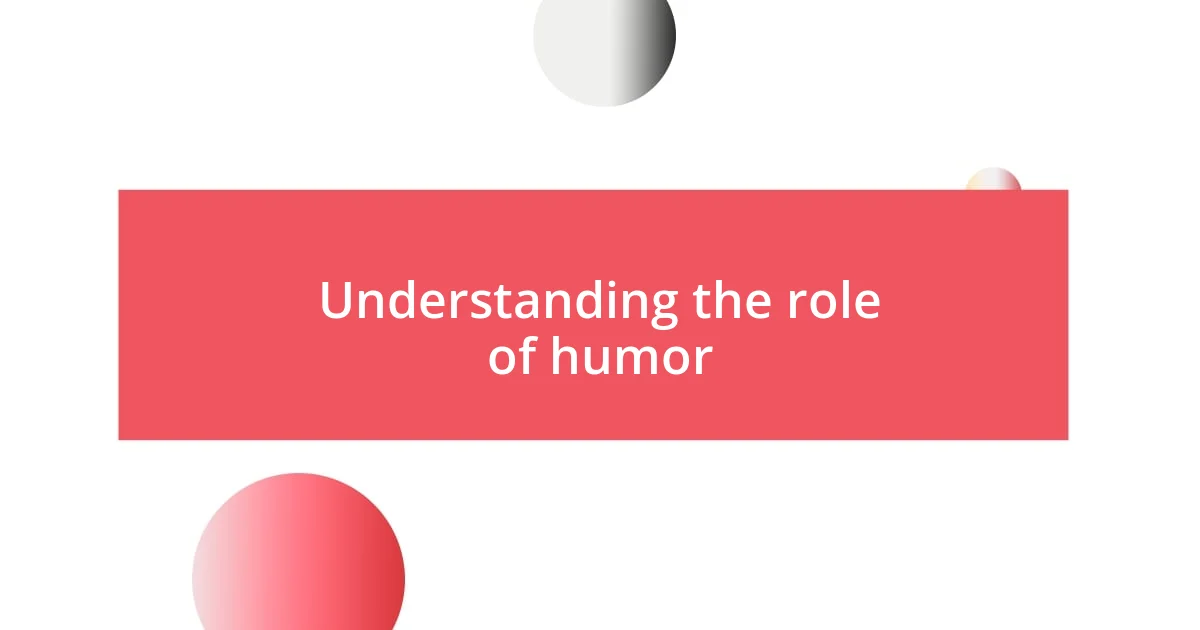
Understanding the role of humor
Humor plays a pivotal role in speeches, often serving as a bridge to connect with the audience. I remember delivering a talk at a community event where I started with a light-hearted joke about my own cooking disasters. It instantly made people laugh and shifted the atmosphere from formal to relaxed, allowing everyone to feel more engaged and open.
One important aspect of using humor is its ability to break down barriers. When I share a personal story that contrasts a serious message with a comedic twist, I notice the audience’s tension dissolving. Have you ever felt that moment when laughter brings a room together? I certainly have—the collective chuckles act as a reminder that we all share imperfect experiences, creating a sense of unity that can enhance the overall message.
Moreover, humor can aid in memory retention. For instance, while addressing a group on the importance of teamwork, I sprinkled in a funny analogy about cats and dogs collaborating in an office. The image was amusing, but it also drove the point home more effectively than facts alone. By weaving humor into meaningful content, we can help our audience remember concepts long after the speech is over.
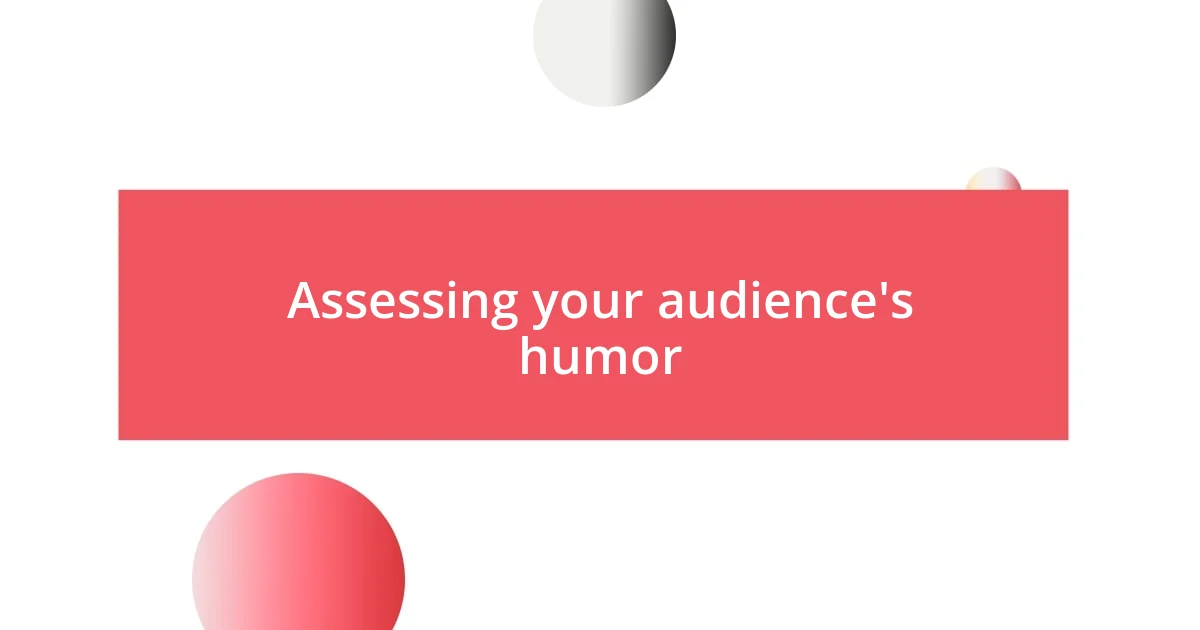
Assessing your audience’s humor
Understanding your audience’s humor is essential for tailoring your speech effectively. I recall a particular workshop where participants varied widely in age and cultural backgrounds. When I decided to test a joke, the laughter from one demographic contrasted sharply with the silence from another. It was a sudden realization that humor is subjective, shaped by factors like experience, context, and even cultural nuances. Have you ever found yourself laughing alone, while others stare blankly? It can be awkward, but it reveals the importance of knowing who you’re speaking to.
Another important angle is gauging the audience’s mood. I once faced a group that had just come from a tense meeting—believe me, cracking a joke about the weather fell flat. Instead, I opted for a light-hearted comment about Mondays, which seemed to resonate much better. I learned that sometimes, humor needs to align with the emotional landscape of the room. Is the audience open to lightheartedness, or are they still processing something serious? Balancing humor is all about reading those vibes.
To take it further, analyzing demographic data is invaluable. At a conference filled with seasoned professionals, I found that sophisticated humor about industry challenges worked wonders. Whereas, at a local school, a simple, playful twist on common student experiences landed with an enthusiastic cheer. This experience has made me realize how deeply intertwined humor is with audience identification. So, what’s the best way to connect humor to the audience’s interests? It all boils down to understanding their backgrounds and preferences thoroughly.
| Audience Type | Humor Approach |
|---|---|
| Younger audience | Playful, relatable humor |
| Corporate professionals | Sophisticated industry-related humor |
| Mixed demographic | Universal humor with personal touch |
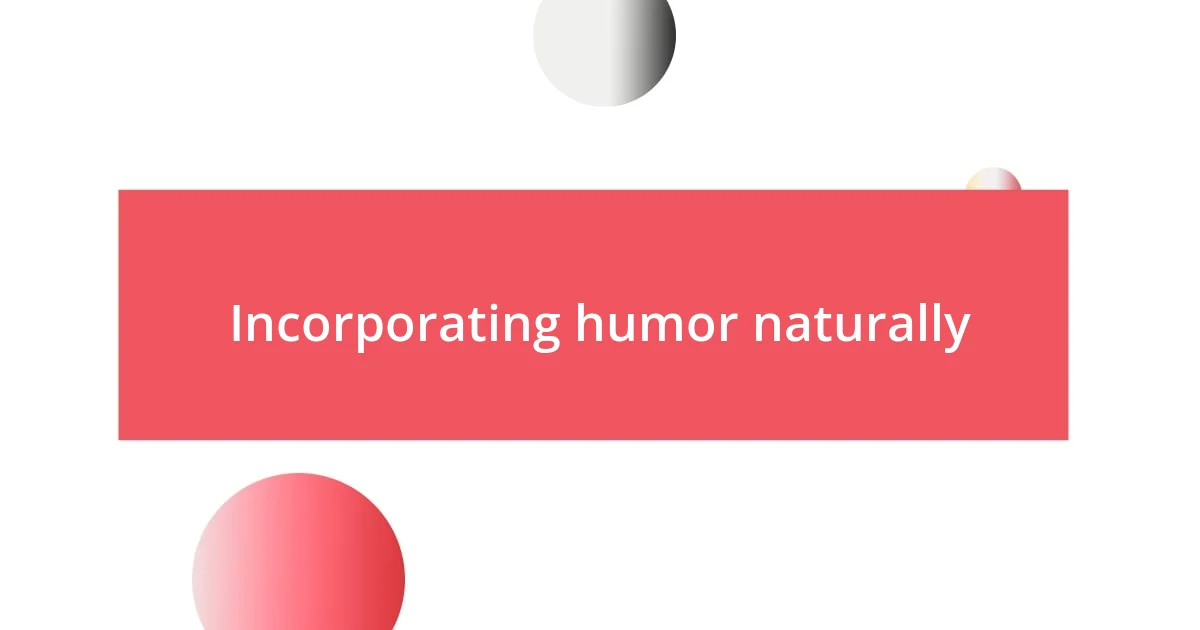
Incorporating humor naturally
Incorporating humor naturally into a speech can feel like walking a tightrope, but it’s all about being authentic. I recall a time when I shared a clumsy moment from my past while discussing the importance of embracing mistakes. People were laughing, not just at my story, but with me as I reminded them that falling short is part of learning. When humor reveals our vulnerabilities, it resonates deeply. That shared laughter nurtures a connection, creating an inviting space for my message to unfold.
To make humor feel seamless in your speech, here are some practical tips:
- Use Personal Stories: Draw from your own life experiences. They’re relatable and often humorous in a genuine way.
- Match the Tone: Ensure your humor fits the overall theme of your speech. If it’s a serious topic, find light moments without undermining the message.
- Timing is Key: Sprinkle in humor at just the right moments, ideally when the audience is most engaged and receptive.
- Be Observant: Pay attention to audience reactions. If a joke doesn’t land, don’t dwell on it—just move on to something else.
- Keep It Light: Avoid topics that could be controversial or sensitive. Aim to uplift rather than risk offense.
- Practice Delivery: The way you deliver a joke can make or break it, so rehearse it until it feels natural and confident.
In my experience, humor should never feel forced; instead, aim for it to emerge organically from your narrative.
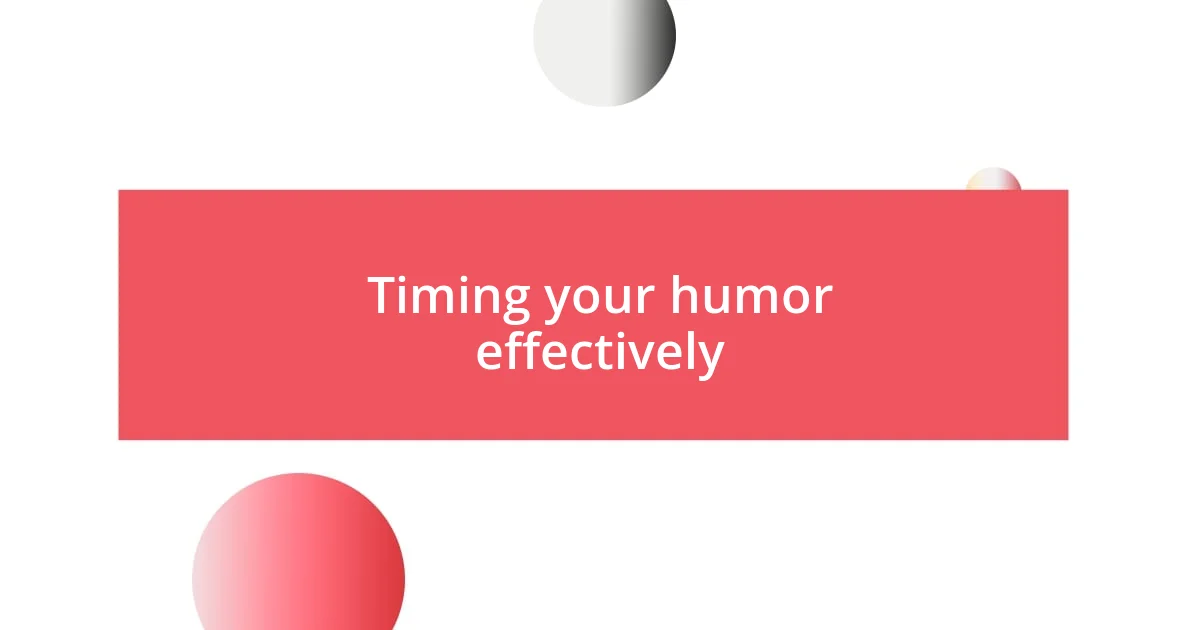
Timing your humor effectively
Timing truly is the heartbeat of humor in speeches. I remember a moment when I shared a lighthearted joke right before diving into a deep topic. The audience was primed and laughing, which made my transition feel smoother. It’s as if laughter acted as a bridge to a more serious discussion. Have you noticed how a well-timed joke can change the room’s energy? It’s like flipping a switch that brightens everything.
In my experience, the best moments for humor often arise unexpectedly. I once cracked a joke about my struggle with tech gadgets during a presentation about digital innovation. The audience sighed with relief, realizing they weren’t alone in their frustrations. That timing turned a potentially dry topic into a lively dialogue. It reminds me that humor doesn’t have to be scripted; it can emerge naturally when we’re in tune with our audience’s collective mood.
Another crucial aspect of timing is pacing. I’ve learned that inserting humor too frequently can feel overwhelming, while too little can make a speech feel flat. For instance, during a TED Talk, I found that placing a witty remark after a heavy statistic provided a needed breath of fresh air. It allowed the laughter to settle before I moved on to the next point. How do you find that balance? It often comes with practice and a willingness to adjust based on audience reactions. Each speech is a unique performance—one where timing can transform good into great.
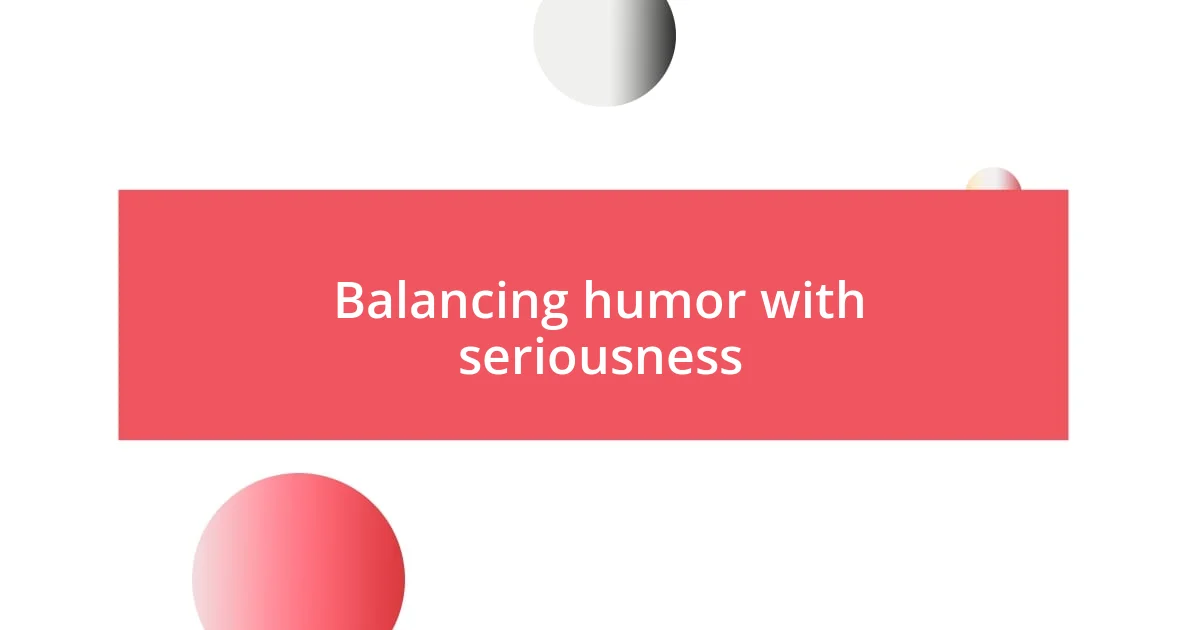
Balancing humor with seriousness
Finding the right balance between humor and seriousness can be tricky, yet it’s essential for impactful speeches. I once delivered a talk on mental health, and right after sharing a rather poignant statistic, I made a light joke about my own forgetfulness in self-care routines. The laughter created a momentary lift and allowed the audience to relax before we delved deeper into a subject that can often feel heavy. This taught me that humor can diffuse tension while allowing space for the seriousness to resonate.
I think about the time I spoke at a fundraising event, where the stakes were high and emotions ran deep. After addressing a particularly heartfelt story about someone impacted by our cause, I purposely inserted a playful comment about my cooking skills—or lack thereof. That small moment of levity reminded everyone that, while we were there to discuss serious matters, it was also okay to share a laugh. Have you ever noticed how a sprinkle of humor can make tough topics feel slightly less daunting? It’s as if humor opens the door to honesty and connection.
In my experience, it’s crucial to be attuned to the audience’s emotions during such moments. I remember once feeling the room shift—a mixture of seriousness and tension—after I discussed some challenging facts. Sensing that, I shared a light-hearted anecdote about the awkward moments I encountered while trying to explain complex issues to my children. The audience’s laughter was palpable, and it transformed the atmosphere, making it easier for everyone to engage with the heavier material that followed. Balancing humor with seriousness is not just about timing; it’s about reading the room and knowing when to uplift the spirits before diving back into deeper reflections.

Practicing humor in delivery
When it comes to practicing humor in delivery, I can’t emphasize enough how rehearsing your timing can pay off. The first time I tried to deliver a humorous anecdote in front of an audience, the punchline stumbled out too quickly, leaving everyone a bit confused rather than entertained. It taught me the value of pacing. Allowing moments for the laughter to settle can transform a good joke into a memorable one—it’s like letting a fine wine breathe.
I remember another occasion where I practiced a self-deprecating joke at a workshop. I worried it might not land, but I felt the energy shift when my audience related to my struggles. That comfort level was palpable; laughter erupted, and suddenly, sharing my journey felt less intimidating. This taught me that not only is humor about the punchline, but also about the storytelling that connects us. Have you ever noticed how laughter can instantly create a bond?
Rehearsing in front of a mirror or with friends has become my go-to strategy for ensuring my delivery hits just right. I once gathered a small group to play around with different jokes related to a presentation. The feedback was invaluable, and I learned how my body language could enhance a punchline. It’s amazing how a slight pause or a smile can amplify the humor. This practice ultimately led to a much more engaging delivery, reminding me that refining humor is an ongoing journey of trial and error.










